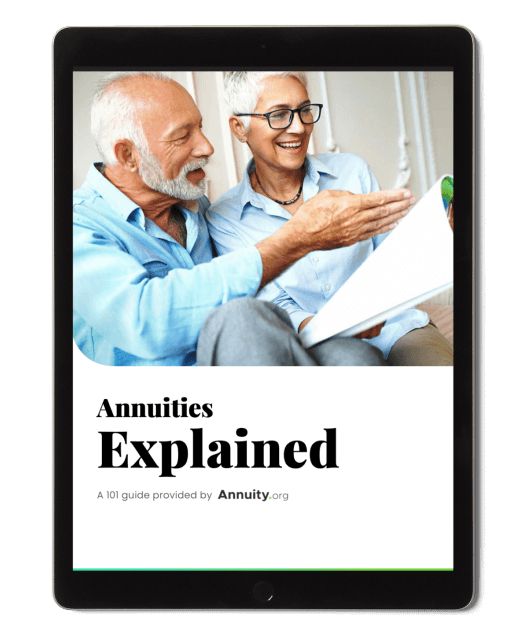What Is a Medicaid-Compliant Annuity?
Medicaid annuities are financial products that help spouses of Medicaid recipients continue to pay their bills in retirement.
To qualify for Medicaid, a person must spend almost everything they have. But, if one spouse doesn’t require long-term care, this can leave the healthy spouse impoverished as well.
Essentially, the Medicaid annuity provides a loophole to qualify one spouse for Medicaid while ensuring that the healthy spouse has a steady monthly income.
The Medicaid annuity enables the healthy spouse to receive a source of income to supplement Social Security if the other spouse needs Medicaid for long-term care. Because long-term care isn’t typically covered by Medicare, it’s essential to have coverage options set in place within your retirement plan.
Key Facts About Medicaid-Compliant Annuities
- A Medicaid-compliant annuity lowers your assets so one spouse can qualify for Medicaid benefits and the other can receive the annuity’s supplemental income.
- You can use your Medicaid-compliant annuity to get coverage for long-term care costs, which aren’t covered by Medicare.
- There are asset and income limits, which can be altered by an annuity, that can potentially qualify or disqualify you for Medicaid coverage.
- While the Medicaid-compliant annuity requirements vary by state, most allow the applicant up to $2,901 a month in income to qualify for Medicaid in 2025.
- The 2025 asset limit is $2,000 per applicant, and your home, car and personal belongings do not count as assets.
Decide if a Medicaid annuity suits your needs before purchasing. Andrew Lokenauth, the Vice President of Financial Reporting at Amalgamated Bank, told Annuity.org, “A Medicaid-compliant annuity is typically recommended for individuals who have significant assets with concerns about protecting them (if long-term care is needed) and are planning to apply for Medicaid coverage for long-term care expenses in the future.”
The rules of Medicaid annuities are very strict and must be followed precisely, so it is strongly recommended that you consult an expert in elder-care law when purchasing a Medicaid-compliant annuity.
“A Medicaid-compliant annuity is typically recommended for individuals who have significant assets with concerns about protecting them (if long-term care is needed) and are planning to apply for Medicaid coverage for long-term care expenses in the future.”

Is An Annuity Right For You?
Medicaid-Compliant Annuity Requirements
While there are general rules for an annuity to be Medicaid-compliant, the requirements can vary depending on which state you live in. Below are the rules that make most annuities Medicaid compliant in most states.
Medicaid-Compliant Rules for Annuities
- The annuity must be irrevocable, meaning it cannot be canceled or changed once it has been set up.
- The annuity must be non-assignable with no cash value, meaning only you and your Medicaid beneficiary have value in it.
- The annuity must be actuarially sound, which means it cannot exceed the life expectancy of the individual receiving annuity payments.
- The annuity income must be used for care services if you require long-term care in the future.
- Whoever purchases the annuity must get back the investment of the annuity in its entirety during their life expectancy.
- The annuity must be structured in a way that the fixed payments are made to the annuitant on a periodic basis (such as monthly or quarterly), not a lump sum.
- You must name your state’s Medicaid program as the primary beneficiary in the event of the annuitant’s death.
In 2005, as part of the Deficit Reduction Act (DRA), Congress tightened the requirements for qualifying for Medicaid.
According to the Centers for Medicare and Medicaid Services, the Deficit Reduction Act of 2005 introduced rules that “discourage the improper transfer of assets to gain Medicaid eligibility and receive long-term care services.”
As a condition of eligibility for coverage of long-term care services, Medicaid applicants are required to disclose any interest in an annuity.
I have had clients who have thought of buying annuities, but being on Medicaid and asset rules are so low, they are afraid that their Medicaid status would be in jeopardy. Medicaid-compliant annuities are the way to go, so that those applicants still meet the Medicaid asset criteria. It also helps married couples, as I have seen in my experience where one spouse can still receive supplementary income.
How Do Medicaid-Compliant Annuities Work?
If you purchase a Medicaid-compliant annuity, you will give a lump sum of money to the annuity provider in exchange for equal amounts of monthly payments to the healthy spouse. By depleting your assets with the lump sum, you now qualify the other spouse for Medicaid assistance for long-term care.
This way, the healthy spouse will receive a continuous stream of monthly income, while Medicaid care coverage is provided for the other.
To better understand a Medicaid-compliant annuity, let’s break down two scenarios which showcase how a Medicaid annuity can help your retirement plan.
Let’s say you and your spouse have $350,000 in your savings, which disqualifies you for Medicaid coverage. In 2024, most states only allow you and your spouse to have as much as $154,140 in assets (in addition to the $2,000 from the applicant spouse) to qualify for Medicaid, according to the American Council on Aging.
If you or your spouse suddenly need long-term care, you could have issues covering health care costs since you have too much in assets to qualify for Medicaid, and Medicare doesn’t cover most long-term care services.
According to Genworth’s Cost of Care Survey, a home health aide who provides long-term care services costs $5,462 per month on average in 2023.
Potential Scenario Outcomes With or Without a Medicaid-Compliant Annuity
If you purchase a Medicaid-compliant annuity, you will give a lump sum of money to the annuity provider in exchange for equal amounts of monthly payments to the healthy spouse. By depleting your assets with the lump sum, you now qualify the other spouse for Medicaid assistance for long-term care.
This way, the healthy spouse will receive a continuous stream of monthly income, while Medicaid care coverage is provided for the other.
To better understand a Medicaid-compliant annuity, let’s break down two scenarios which showcase how a Medicaid annuity can help your retirement plan.
Let’s say you and your spouse have $350,000 in your savings, which disqualifies you for Medicaid coverage. In 2025, most states only allow you and your spouse to have as much as $157,920 in assets (in addition to the $2,000 from the applicant spouse) to qualify for Medicaid, according to the American Council on Aging.
If you or your spouse suddenly need long-term care, you could have issues covering health care costs since you have too much in assets to qualify for Medicaid, and Medicare doesn’t cover most long-term care services.
According to Genworth’s Cost of Care Survey, a home health aide who provides long-term care services costs $6,483 per month on average in 2025.
Potential Scenario Outcomes With or Without a Medicaid-Compliant Annuity
Without an Annuity
According to Genworth’s projected long-term care cost, if you and your spouse use up all your $350,000 savings for long-term care services, your savings will be depleted in less than five years.
Medicaid will only kick in after your assets are gone or lowered to your state’s regulated amount. By that point, the healthy spouse won’t have any additional income besides their social security check.
With an Annuity
You could invest $250,000 of your $350,000 in a Medicaid-compliant annuity, which still leaves $100,000 in your savings. Since $100,000 is below the $157,920 asset limit, you will likely qualify for Medicaid coverage. However, each state’s asset limit is different, so confirm the amount with an expert in elder-care law before purchasing the annuity.
This way you still have $100,000 in your savings, and one spouse can qualify for Medicaid while the healthy spouse receives additional monthly income from the Medicaid-compliant annuity.
Your retirement funds are secured, and you have coverage to help with long-term care costs.
According to Genworth’s projected long-term care cost, if you and your spouse use up all your $350,000 savings for long-term care services, your savings will be depleted in less than six years.
Medicaid will only kick in after your assets are gone or lowered to your state’s regulated amount. By that point, the healthy spouse won’t have any additional income besides their social security check.
With an Annuity
You could invest $250,000 of your $350,000 in a Medicaid-compliant annuity, which still leaves $100,000 in your savings. Since $100,000 is below the $154,140 asset limit, you will likely qualify for Medicaid coverage. However, each state’s asset limit is different, so confirm the amount with an expert in elder-care law before purchasing the annuity.
This way you still have $100,000 in your savings, and one spouse can qualify for Medicaid while the healthy spouse receives additional monthly income from the Medicaid-compliant annuity.
Your retirement funds are secured, and you have coverage to help with long-term care costs.

Learn About How Annuities Can Bolster Your Retirement Strategy
How Do Annuities Affect Medicaid Limits on Assets and Income?
If an annuity’s payments make your asset or income above Medicaid’s limits, you could become ineligible for Medicaid. Keep in mind that each state has different asset and income limits.
For example, if you live in Texas and are looking for nursing home care covered by Medicaid, your income limit is $2,901 per month and asset limit is $2,000 in 2025. The limits can differ based on your marriage status and if one or both spouses are applying. The American Council on Aging has a breakdown sheet with each state’s Medicaid limits on assets and income.
Below are general Medicaid limits on assets and income that most states follow in 2025.
- Assets
- Most states have an asset limit of $2,000 for an individual applicant to be eligible for Medicaid. If you’re married, your assets are considered jointly owned. Some assets, like your home, personal belongings and vehicle are not accounted for in your asset limit.
If you’re married, and your spouse doesn’t need Medicaid coverage, the If you’re married, and your spouse doesn’t need Medicaid coverage, the Community Spouse Resource Allowance (CSRA) allows your spouse to have a higher asset amount. In 2024, most states allow your spouse to retain roughly $157,920 in assets, along with the $2,000. - Income
- The income limit is $2,901 a month for an individual applicant. Remember, your monthly annuity payment converts your lump sum of cash into income instead of an asset, meaning your annuity payment can make you ineligible for Medicaid if it’s too high.
2025 Medicaid Asset and Income Limits
Source: American Council on Aging
Types of Medicaid-Compliant Annuities
Immediate and fixed annuities are Medicaid-compliant. In some cases, a variable annuity can also be Medicaid-compliant.
Remember, not all annuities are Medicaid-compliant. If you select the wrong one, you could accidentally disqualify you and your spouse for Medicaid coverage.
Which Annuity Is Medicaid Compliant?
Pros
- Immediate Annuity
- Fixed Annuity
Cons
- Deferred Annuity
- Variable Annuity*
- Lifetime Annuities
Source: American Council on Aging
*In rare cases, a variable annuity could be Medicaid compliant, but it is unlikely.
If you already have a deferred annuity, you can convert it into an immediate annuity with a financial expert’s aid. This way, your annuity will become Medicaid-compliant.
Non-Compliant Annuities and Medicaid
If you’re a Medicaid applicant with an annuity inside of a qualified retirement plan, also known as a qualified annuity, that annuity is not counted as an asset that limits Medicaid eligibility.
However, the Internal Revenue Service mandates that once the holder of a qualified annuity reaches the age of 73, they must withdraw a minimum amount each year. This is known as a required minimum distribution (RMD). Medicaid rules require that RMD withdrawals be turned over to the nursing home to cover costs.
In general, if the rules for Medicaid compliance weren’t followed when a non-qualified annuity was purchased, it is counted when determining Medicaid eligibility. However, a non-qualified annuity can be transferred to the healthy spouse without creating issues with Medicaid rules or creating tax problems.
If the owner of a non-qualified annuity doesn’t have a healthy spouse, they may assign the annuity to a Medicaid Trust. This allows the annuity holder to keep the income payments and start the five-year look-back period for Medicaid eligibility.

Get Your Free Guide to Annuities
How Marital Status Affects Your Application
In most cases, if you’re applying as a single applicant, or even if you’re a married applicant with a spouse, you’re going to apply as an individual applicant. However, this rule varies depending on which state you live in.
Generally, no matter what your marriage status is, you should confirm that your income doesn’t surpass Medicaid’s limit for eligibility. In 2025, a single applicant looking for long-term care through a Home and Community Based Services (HCBS) Medicaid waiver can retain up to $2,901 a month in income to be eligible, according to the American Council on Aging.
- Single Applicant
- If it’s only yourself applying for the Medicaid-compliant annuity, your income can affect your Medicaid eligibility. If your annuity payment puts you above the income limit, you won’t qualify for Medicaid.
If you decide to go into a nursing home, you can keep a personal needs allowance of $30 to $200 of your income per month to cover personal needs costs not covered by the home. The rest of your income will go to the nursing home for care costs. If you purchase an annuity with income greater than the cost of your care, you won’t qualify for Medicaid. - Married Applicant With Non-Applicant Spouse
- In this scenario, only one spouse needs Medicaid covered long-term care. Only the income of the spouse applying for coverage will be accounted for.
While assets owned by either spouse are jointly owned, income is not. This makes non-exempt assets into non-countable assets for the spouse who doesn’t need Medicaid coverage. - Married With Both Spouses as Applicants
- If you and your spouse need long-term care, consider Medicaid-compliant annuities. Most of your annuity payments will go towards paying the nursing home, so make sure your payments don’t surpass the monthly limits. If your annuity payments surpass long-term care costs, you may become ineligible for Medicaid.
Marital Status
Source: American Council on Aging
Remember that the state you live in will also impact the rules for your Medicaid eligibility. Your income, asset limit and what level of care you need will vary. Below is a chart showing your limits if you were looking to apply for nursing home Medicaid coverage in Florida.
Income and Asset Medicaid Limits Based on Marriage Status
| Single Applicant | Married Applicant With Non-Applicant Spouse | Married With Both Spouses as Applicants | |
|---|---|---|---|
| Income Limit | $2,901 a month, along with a $160 personal needs allowance | $2,901 a month, along with a $160 personal needs allowance | $5,802 a month ($2,901 a month per spouse) |
| Asset Limit | $2,000 | $2,000 for the applicant and $157,920 for the non-applicant spouse | $3,000 |
Will You Be Able To Maintain Your Retirement Lifestyle?
Learn how annuities can:
- Help protect your savings from market volatility
- Guarantee income for life
- Safeguard your family
- Help you plan for long-term care
Speak with a licensed agent about top providers and how much you need to invest.
Medicaid Annuity Frequently Asked Questions
No, Medicaid should not be able to take your Medicaid-compliant annuity if you go into a nursing home. The main purpose of this type of annuity is to qualify for long-term care coverage. Confirm with an elder-law expert to be certain, for rules vary by state.
If your annuity is Medicaid-compliant, it can lower your assets so you can qualify for Medicaid coverage. Each state has a different asset limit, so it’s best to confirm your state’s Medicaid eligibility requirements before buying an annuity.
Whether a Medicaid annuity is a good idea or not depends on your finances and health needs. You need a large lump sum to purchase a Medicaid annuity. If you have concerns about you or your spouse needing long-term care in the future, and you have a large amount of assets, it would be a good idea to consider an annuity which complies with Medicaid regulations.
Editor Samantha Connell contributed to this article.







